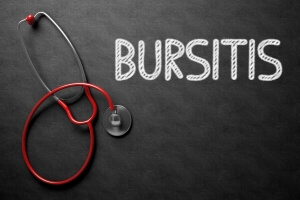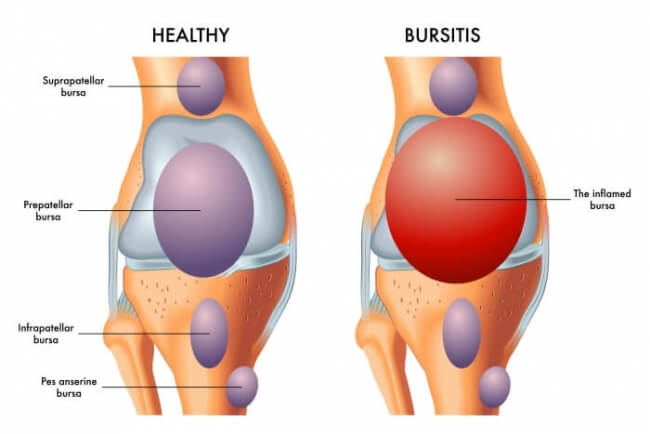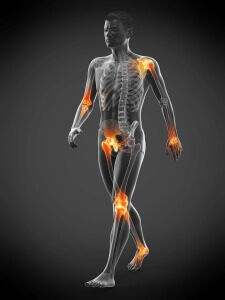 With over 50 million Americans in the United States suffering from some form of arthritis, it is understandable that one may assume that the pain they are experiencing in their joints is arthritis related. Though that statement could be very true to some extent, not all joint pain is a direct cause of arthritis. A condition called bursitis, which commonly affects the joints in the body, could be the cause of pain in your joints and the areas that surround it.
With over 50 million Americans in the United States suffering from some form of arthritis, it is understandable that one may assume that the pain they are experiencing in their joints is arthritis related. Though that statement could be very true to some extent, not all joint pain is a direct cause of arthritis. A condition called bursitis, which commonly affects the joints in the body, could be the cause of pain in your joints and the areas that surround it.
What Causes Bursitis?

Bursitis (bur-SY-tis) is a painful condition that affects the small, fluid-filled sacs called bursae (bur-SEE), which cushion the bones, tendons and muscles near your joints. Bursitis occurs when bursae become inflamed. There are over 150 known bursae in the human body. Although bursitis can occur in any number of places in the body where bursae are found, the most common forms of bursitis occur in your shoulders, hips, elbows, knees, and ankles. The biggest difference between bursitis and arthritis is that, if properly treated, bursitis can go away within a few weeks. In contrast, arthritis is a long-term condition that can cause pain within the joints.
Causes of bursitis are:
- Overuse from repetitive activities
- Poor posture and improper walking habits
- Deformities in the joints or bones that cause stress on soft tissue
- Metabolic disorders such as diabetes
- Side effects from certain medications
- Autoimmune diseases such as rheumatoid arthritis (RA)
What are Some Common Types of Bursitis?

- Subacromial Bursitis (Shoulder)- This type occurs when your subacromial bursa becomes inflamed. Your subacromial bursa helps pad your rotator cuff, when inflammation occurs, it becomes extremely painful to move. Although this can be the result of a direct injury, it is more commonly due to overuse. Pitchers and other athletes that play sports that require a throwing motion are susceptible to this kind of injury, as well as those who have jobs that require a lot of overhead lifting or pulling. Some symptoms include shoulder pain, swelling, redness and soreness to the touch. In advanced cases of bursitis, you may not be able to move your shoulder at all leading to a condition called “Frozen Shoulder”.
- Trochanteric Bursitis (Hip)- This type occurs when your trochanteric bursa becomes inflamed. This bursa is located on the outside point of the hip called the greater trochanter and can be caused by overuse or injury. A common injury to runners and bicyclists often occur when a long connective tissue called the iliotibial band (ITB), which runs down from the hip to the knee becomes tight from overuse and rubs against the trochanteric bursa, thus causing irritation and leading to bursitis. Other contributing factors are poor posture, muscle tears, hip injuries and diseases such as arthritis. Some symptoms include a sharp pain on the outside of your hip which slowly turns into a dull aching pain over time. Many patients will have difficulty sleeping on their affected side. You may experience pain down the upper portion of your leg. Going downstairs, crossing your legs, getting up from a sitting position and laying down on your affected hip may all increase the pain in your hip joint. Whereas problems deep down in the hip joint typically cause pain in the groin, hip bursitis typically causes pain on the side of the hip. Fortunately, hip bursitis is very easily and successfully treated in most cases with injections and physical therapy.
- Olecranon Bursitis (Elbow)- Also known as “Popeye’s elbow” due to severe cases of swelling around the tip of the elbow. This type occurs when your olecranon bursa becomes inflamed. If you were to bend your elbow, this would refer to the pointy bone that juts out. This can be caused by a hard blow to the elbow or falling on top of it with heavy force. It is also caused by leaning on your elbows against hard surfaces for long periods of time. This is quite common for those who have jobs that require them to work on their elbows, such as plumbers or HVAC technicians. Some symptoms include, pain in and around the elbow, swelling, redness, and tenderness to the touch. These can occasionally become infected and be extremely warm, red and painful though antibiotics can generally treat these effectively.
- Retrocalcaneal Bursitis (Achilles Tendon)- This type occurs when the retrocalcaneal bursa located between the Achilles tendon and the heel bone becomes inflamed. This is also known as Achilles tendon bursitis. When the Achilles tendon repeatedly rubs against the retrocalcaneal bursa, it causes friction and can gradually lead to inflammation. This is more common in repetitive activities such as running or jumping. Other more immediate causes can be from a direct blow to the back of the heel or from a fall. Some symptoms may include pain or swelling in the back of the heel, calf pain when running or walking, pain when leaning back on the heel and redness. Subcutaneous Calcaneal Bursitis (Heel) is the swelling of the subcutaneous calcaneal bursa located just below the retrocalcaneal bursa on the back of the heel. This is commonly caused by improper footwear or an impact to the area. Medial Malleolar Bursitis (Ankle) occurs when there is an inflammation of the bursa of the medial malleolus. This is commonly caused by a direct impact to the bursa of the medial malleolus, which is the protruding bone on the inside of your ankle.
- Knee Bursitis- Three main bursae make up the knee joint commonly associated with bursitis. Prepatellar Bursitis (Knee) is caused when the prepatellar bursa, which is located over the kneecap bone becomes inflamed. This usually occurs from prolonged kneeling and is often referred to as “carpet layer’s knee” or “roofer’s knee”. Infrapatellar Bursitis is caused when the infrapatellar bursa, which is located beneath the kneecap becomes inflamed. This is usually the result of a jumping injury and is often referred to as “jumper’s knee”. Pes Anserine Bursitis is caused when the pes anserine bursa, which is located on the inner lower side of the knee becomes inflamed.
- Septic Bursitis- This type occurs when inflammation of the bursae is caused by an infection. Bacteria can be introduced through trauma or skin puncture at the site of the bursa which can eventually lead to infection. An infected bursa will sometimes discharge a yellowish or white cloudy pus. Most commonly, however, septic bursitis presents as a beefy, red and swollen fluid collection over top of a joint. This type of bursitis is one that requires more urgent evaluation to see if drainage or antibiotics are necessary.
What are Some Treatment Options for Bursitis?
There are a variety of treatment options that are commonly used to effectively treat bursitis. The majority of these treatments focus on relieving pain and inflammation to the affected area. Here are some general treatment options typically administered:
- Rest the affected area if possible, or avoid overuse
- Apply an ice pack to the affected area to reduce swelling in the first 48 hours
- Apply heat to the affected area. This can be in the form of a heating pad, heat pack or warm bath
- For foot and ankle bursitis, be sure to use proper footwear. Use a cane or crutches, if needed, to not aggravate the injury
- Taking anti-inflammatory medications that also help to relieve pain, such as over-the-counter medicines like Advil, Aleve, Motrin, etc.
For severe swelling, a physician may choose to drain the excess fluid from the affected area though this is quite rare to require this. Physicians can further use a corticosteroid injection to decrease inflammation. Physical therapy is sometimes ordered to help strengthen the muscles in and around the affected area to help with range-of-motion, stability and mobility. For septic bursitis, antibiotics are used to help fight against the bacterial infection.
Although most bursitis cases can be treated from home, you should seek medical attention if symptoms worsen. This can include:
- Pain lasting more than two weeks
- Severe swelling, redness or bruising
- Joint pain that prevents movement
- Sharp, intense shooting pains
- Fever
These symptoms could indicate a bacterial infection to the affected area known as septic bursitis. Seek immediate medical attention.
What Can I Do to Prevent Bursitis in the Future?

- Warming up before starting any physical activities
- Taking breaks or changing positions every 20 to 40 minutes
- Maintaining a healthy weight by proper dieting
- Protect joints with proper equipment such as knee pads, elbow pads, proper footwear, etc.
- Strengthen core muscles to help improve posture
- Stop any activity that causes pain
Following these simple prevention measures can dramatically reduce your chances of developing bursitis. However, choosing to live a healthy life can go a long way in staving off all types of disorders and diseases in hopes that you can live a long and healthy life.
 The Joint Preservation Center at Towson Orthopaedic Associates offers an innovative, personalized approach to long-term joint health. Utilizing early diagnosis, intervention, and the latest techniques, our orthopaedic surgeons can restore and preserve the joint’s natural ability, which makes it possible to avoid more invasive surgeries and prolonged rehabilitation. Are you suffering from persistent joint pain or stiffness? Call 410-337-7900 to schedule an evaluation or click here to learn how we can help preserve or restore the health of your joints.
The Joint Preservation Center at Towson Orthopaedic Associates offers an innovative, personalized approach to long-term joint health. Utilizing early diagnosis, intervention, and the latest techniques, our orthopaedic surgeons can restore and preserve the joint’s natural ability, which makes it possible to avoid more invasive surgeries and prolonged rehabilitation. Are you suffering from persistent joint pain or stiffness? Call 410-337-7900 to schedule an evaluation or click here to learn how we can help preserve or restore the health of your joints.

